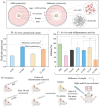Amyloid Fibrils Enhance the Topical Bio-Adhesivity of Liquid Crystalline Mesophase-Based Drug Formulations
- PMID: 36681654
- PMCID: PMC11468793
- DOI: 10.1002/adhm.202202720
Amyloid Fibrils Enhance the Topical Bio-Adhesivity of Liquid Crystalline Mesophase-Based Drug Formulations
Abstract
Despite their distinctive secondary structure based on cross β-strands, amyloid fibrils (AF) are stable fibrous protein aggregates with features similar to collagen, one of the main components of the extracellular matrix, and thus constitute a potential scaffold for enhancing cell adhesion for topical applications. Here, the contribution of AF to skin bio-adhesivity aiming toward topical treatments is investigated. Liquid crystalline mesophase (LCM) based on phytantriol is formulated, with the aqueous phase containing either water or a solution of 4 wt% amyloid fibrils. Then resveratrol is added as a model anti-inflammatory molecule. The developed LCM presents a double gyroid Ia3d mesophase. The incorporation of AF into the LCM increases its bio-adhesive properties. In vitro release and ex vivo permeation and retention confirm the controlled release property of the system, and that resveratrol is retained in epidermis and dermis, but is also permeated through the skin. All formulations are biocompatible with L929 cells. The in vivo assay confirms that systems with AF lead to a higher anti-inflammatory effect of resveratrol. These results confirm the hypothesis that the incorporation of AF in the LCM increases the bio-adhesiveness and efficiency of the system for topical treatment, and consequently, the therapeutical action of the encapsulated drug.
Keywords: amyloid fibrils; bio-adhesiveness; inflammatory diseases; liquid crystalline mesophases; topical treatments.
© 2023 The Authors. Advanced Healthcare Materials published by Wiley-VCH GmbH.
Conflict of interest statement
The authors declare no conflict of interest.
Figures




Similar articles
-
Trans-resveratrol-loaded nonionic lamellar liquid-crystalline systems: structural, rheological, mechanical, textural, and bioadhesive characterization and evaluation of in vivo anti-inflammatory activity.Int J Nanomedicine. 2017 Sep 14;12:6883-6893. doi: 10.2147/IJN.S138629. eCollection 2017. Int J Nanomedicine. 2017. PMID: 29066884 Free PMC article.
-
Design, characterization, and biological evaluation of curcumin-loaded surfactant-based systems for topical drug delivery.Int J Nanomedicine. 2016 Sep 8;11:4553-4562. doi: 10.2147/IJN.S108675. eCollection 2016. Int J Nanomedicine. 2016. PMID: 27660447 Free PMC article.
-
HII mesophase as a drug delivery system for topical application of methyl salicylate.Eur J Pharm Sci. 2017 Mar 30;100:155-162. doi: 10.1016/j.ejps.2016.12.033. Epub 2017 Jan 4. Eur J Pharm Sci. 2017. PMID: 28063969
-
Resveratrol-loaded biopolymer core-shell nanoparticles: bioavailability and anti-inflammatory effects.Food Funct. 2020 May 1;11(5):4014-4025. doi: 10.1039/d0fo00195c. Epub 2020 Apr 23. Food Funct. 2020. PMID: 32322856
-
Resveratrol and resveratrol nano-delivery systems in the treatment of inflammatory bowel disease.J Nutr Biochem. 2022 Nov;109:109101. doi: 10.1016/j.jnutbio.2022.109101. Epub 2022 Jun 29. J Nutr Biochem. 2022. PMID: 35777588 Review.
Cited by
-
Unveiling the multifaceted potential of amyloid fibrils: from pathogenic myths to biotechnological marvels.Biophys Rev. 2024 Sep 30;16(6):737-751. doi: 10.1007/s12551-024-01232-3. eCollection 2024 Dec. Biophys Rev. 2024. PMID: 39830121 Review.
-
Application of Amyloid-Based Hybrid Membranes in Drug Delivery.Polymers (Basel). 2023 Mar 14;15(6):1444. doi: 10.3390/polym15061444. Polymers (Basel). 2023. PMID: 36987222 Free PMC article.
-
Enhanced Hemostatic and Procoagulant Efficacy of PEG/ZnO Hydrogels: A Novel Approach in Traumatic Hemorrhage Management.Gels. 2024 Jan 24;10(2):88. doi: 10.3390/gels10020088. Gels. 2024. PMID: 38391418 Free PMC article.
References
-
- Bolisetty S., Boddupalli C. S., Handschin S., Chaitanya K., Adamcik J., Saito Y., Manz M. G., Mezzenga R., Biomacromolecules 2014, 15, 2793. - PubMed
-
- Cao Y., Mezzenga R., Adv. Colloid Interface Sci. 2019, 269, 334. - PubMed
-
- Das S., Jacob R. S., Patel K., Singh N., Maji S. K., Biomacromolecules 2018, 19, 1826. - PubMed
-
- Adamcik J., Mezzenga R., Angew. Chem., Int. Ed. 2018, 57, 8370. - PubMed
-
- Bolisetty S., Mezzenga R., Nat. Nanotechnol. 2016, 11, 365. - PubMed
Publication types
MeSH terms
Substances
LinkOut - more resources
Full Text Sources

